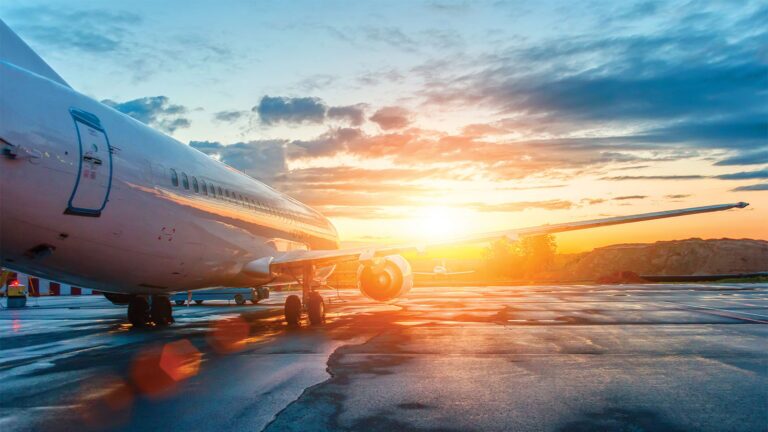Stay Up to Date
Submit your email address to receive the latest industry and Aerospace America news.
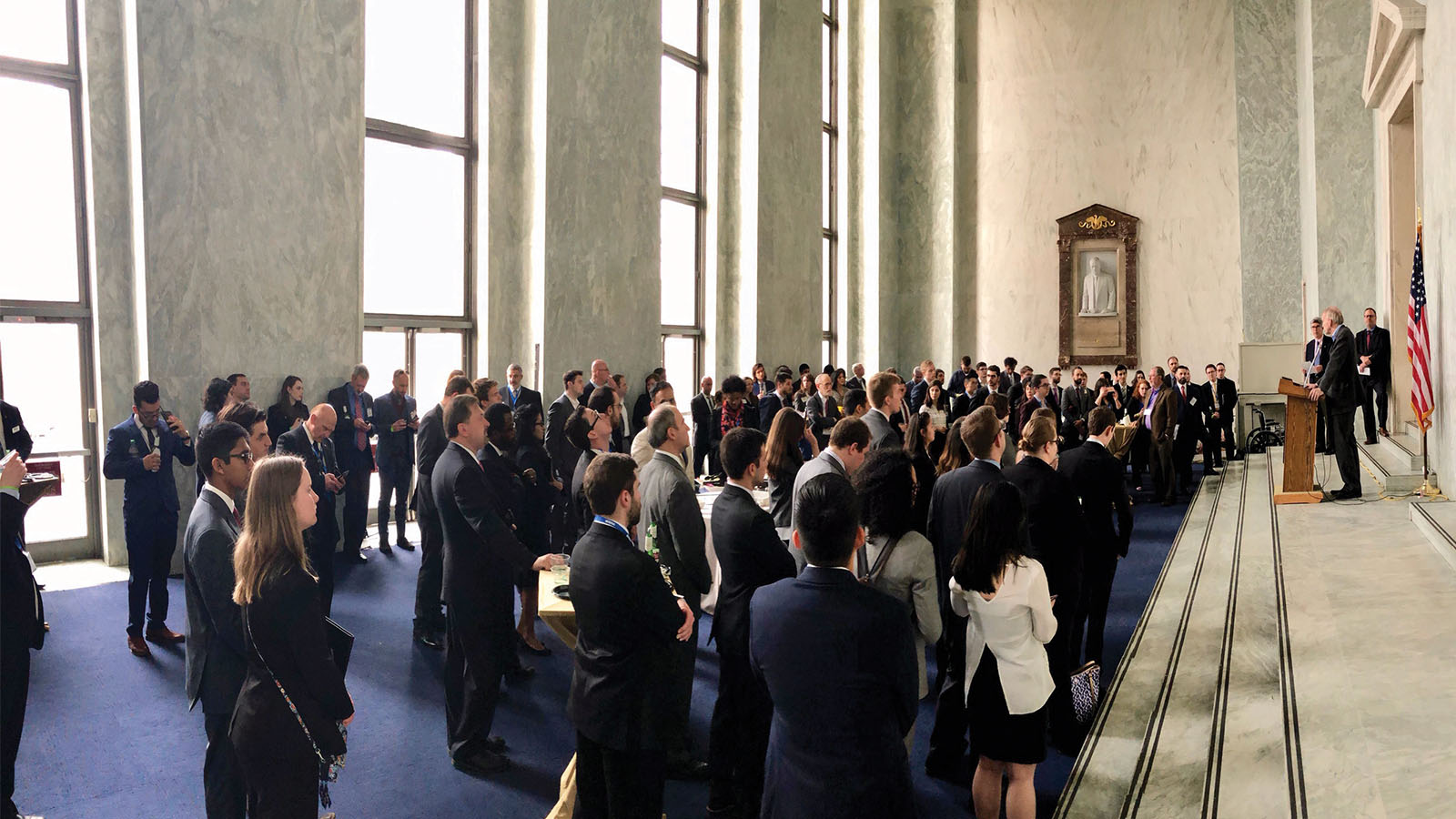
Public Policy
AIAA Outreach on Capitol Hill
AIAA’s 22nd annual Congressional Visits Day (CVD) program took place on 20 March and approximately 175 members representing 36 states and 37 sections took part. State teams visited about 275 offices to help promote the Institute’s 2019 key issues and raise awareness of the long-term value that science, engineering, and technology bring to the nation. Over 60 percent of this year’s participants were students!
Our members’ participation in CVD reminds our lawmakers that aerospace is a key component of an economically strong and secure nation. And there’s more that can be done to address the profession’s public policy needs throughout the year. Reach out to your elected officials to communicate the importance of the aerospace community to our economy, national security, and as an inspiration to the future STEM workforce. Invite lawmakers to participate in your AIAA section’s events and activities or tour a local facility. Be a vocal advocate for aerospace!
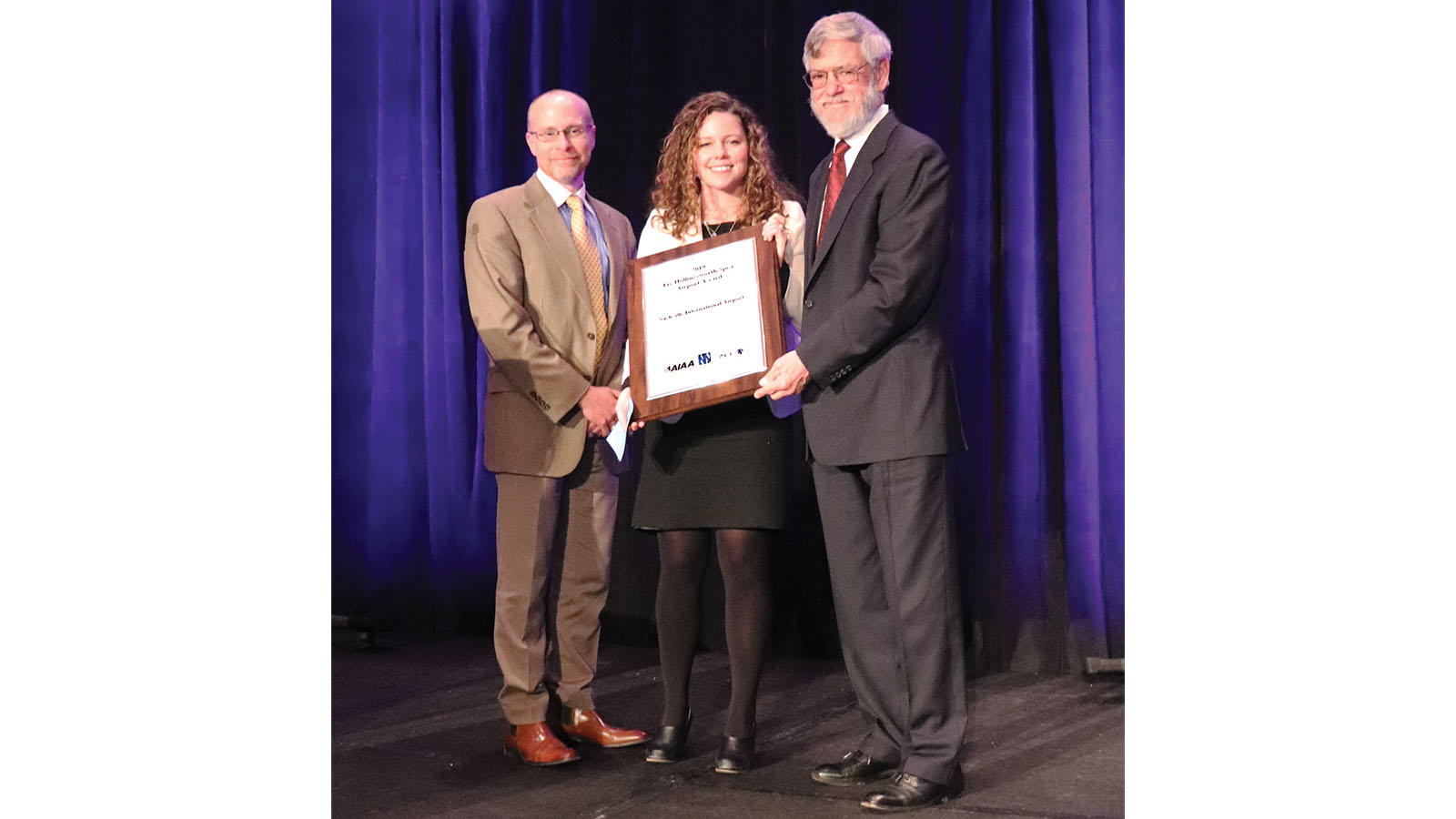
Award Announcements
Nashville International Airport Wins 2019 Speas Airport Award
On 21 February, the 2019 AIAA/AAAE/ACC Jay Hollingsworth Speas Airport Award was presented to the Nashville International Airport during an awards luncheon at the 2019 ACC/AAAE Airport Planning, Design and Construction Symposium. The airport was recognized for creatively transforming a nearby quarry into the largest geothermal lake plate cooling system in North America to provide a sustainable source of water for the airport’s terminal cooling and irrigation needs.”
The Speas award was established in 1983 and is presented annually to the nominee(s) judged to have contributed most significantly in recent years to the enhancement of relationships between airports and/or heliports and their surrounding environments via exemplary innovation that might be replicated elsewhere.
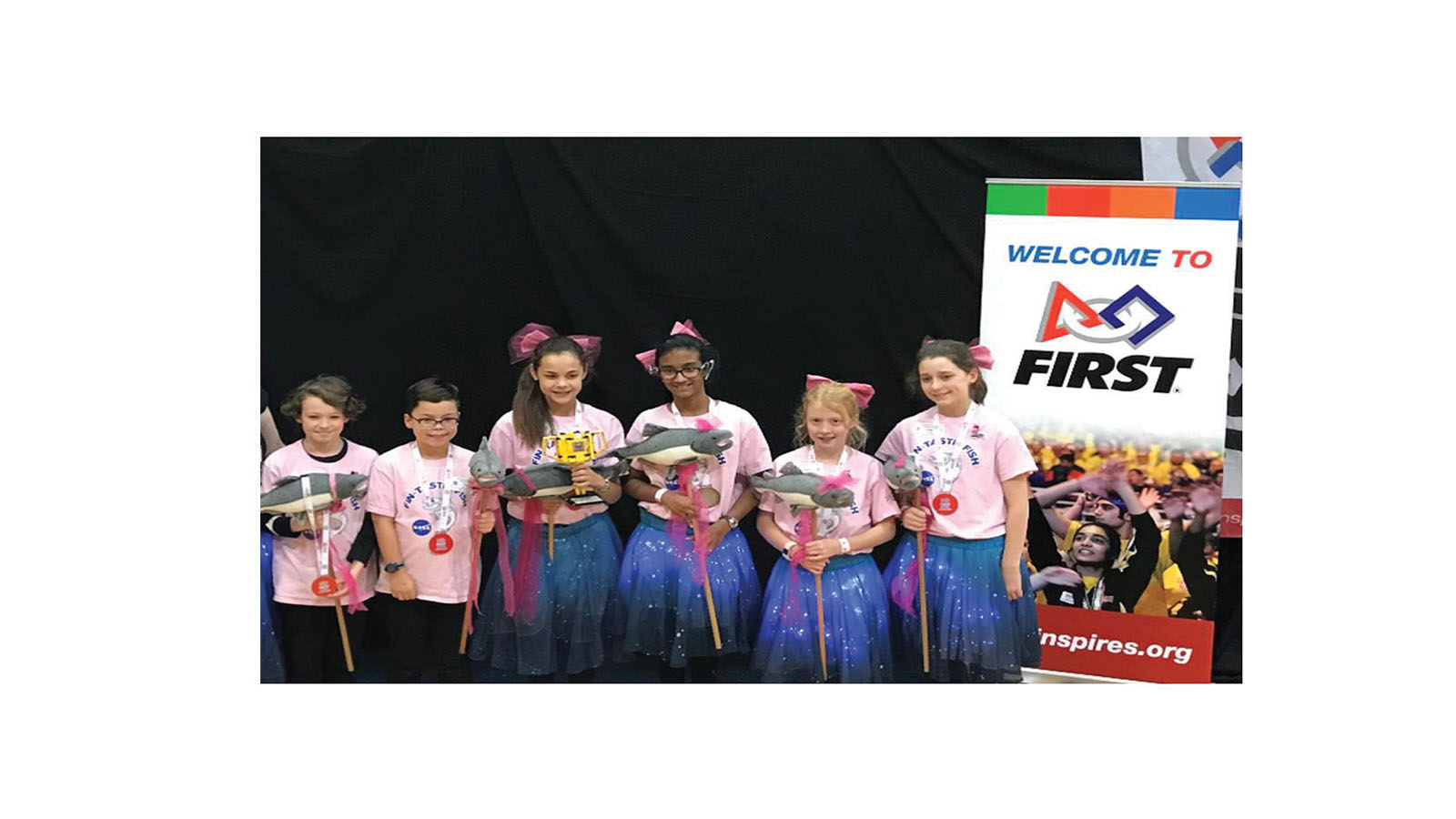
AIAA Foundation
Making an Impact: FIRST® LEGO® League
Looking for ways to show students how much fun STEM can be? AIAA is supporting FIRST® LEGO® League teams. Through this program, new teams can receive up to $500 and existing teams can receive up to $250 to offset costs associated with FIRST® LEGO® League activities. There are no restrictions on how teams may use their grant funds. It can go toward covering the costs of challenge materials, travel expenses, team t-shirts, or anything else the team may need.
Going on its third year, this partnership has generated 493 applications and awarded 480 grants to deserving teams! FIRST® LEGO® League (FLL) team registration and AIAA Foundation grant application opens May 2019 (aiaa.org/firstgrants).
Coached by Dr. Supriya Banerjee, the FAMES® FLL Program at the Boys and Girls Club of Greater Washington sought to inspire students to pursue STEM education. “Support from the AIAA Foundation helps us prepare the next generation of aerospace leaders,” Banerjee said. As one student wrote: “…when I grow up, I want to be an engineer and build something for NASA.”
Coached by Mark Gullickson, the Albany FFL Robotics Team #27006, the Fin-tastic Fish, won First Place Championship Honors at the 2018-2019 State Robotics Championship Tournament. “Our NASA – Into Orbit season was such an amazing experience for us all!” Gullickson said. “Because of our AIAA Foundation FLL Grant, our team discovered how a FLL team from Albany can impact the lives of students just like us all over the world.
“[Inspired by our FLL grant, we had a] … clothing donation drive in which we collected 500+ pairs of new socks for homeless people in our community, [helped] … start an aquaculture fish farm program for girls in rural Vietnam, [and honored] our Veterans by celebrating their service as we marched in the largest Veterans Day parade west of the Mississippi. [The] … AIAA Foundation Grant made it possible for our team to truly put into practice so many ways to honor diversity in our community and all over the world.”
The AIAA Foundation Grant also made it possible for the Fin-tastic Fish to purchase blue colored LEGO parts from different countries all over the world because this LEGO color is nonexistent in large quantities in the USA, Gullickson explained.
“Our robot, Blue Bob, is truly an international robot designed with LEGO pieces from as far away as St. Petersburg, Russia, Holland, Sweden, and Germany,” he said. “Through our involvement with FIRST, and the support our team received from the AIAA Foundation, we have shared our research project and CORE Values successes with more than 35,000 FIRST teams all over the world.”
For more information about the AIAA Foundation and the impact it makes, please visit aiaafoundation.org.
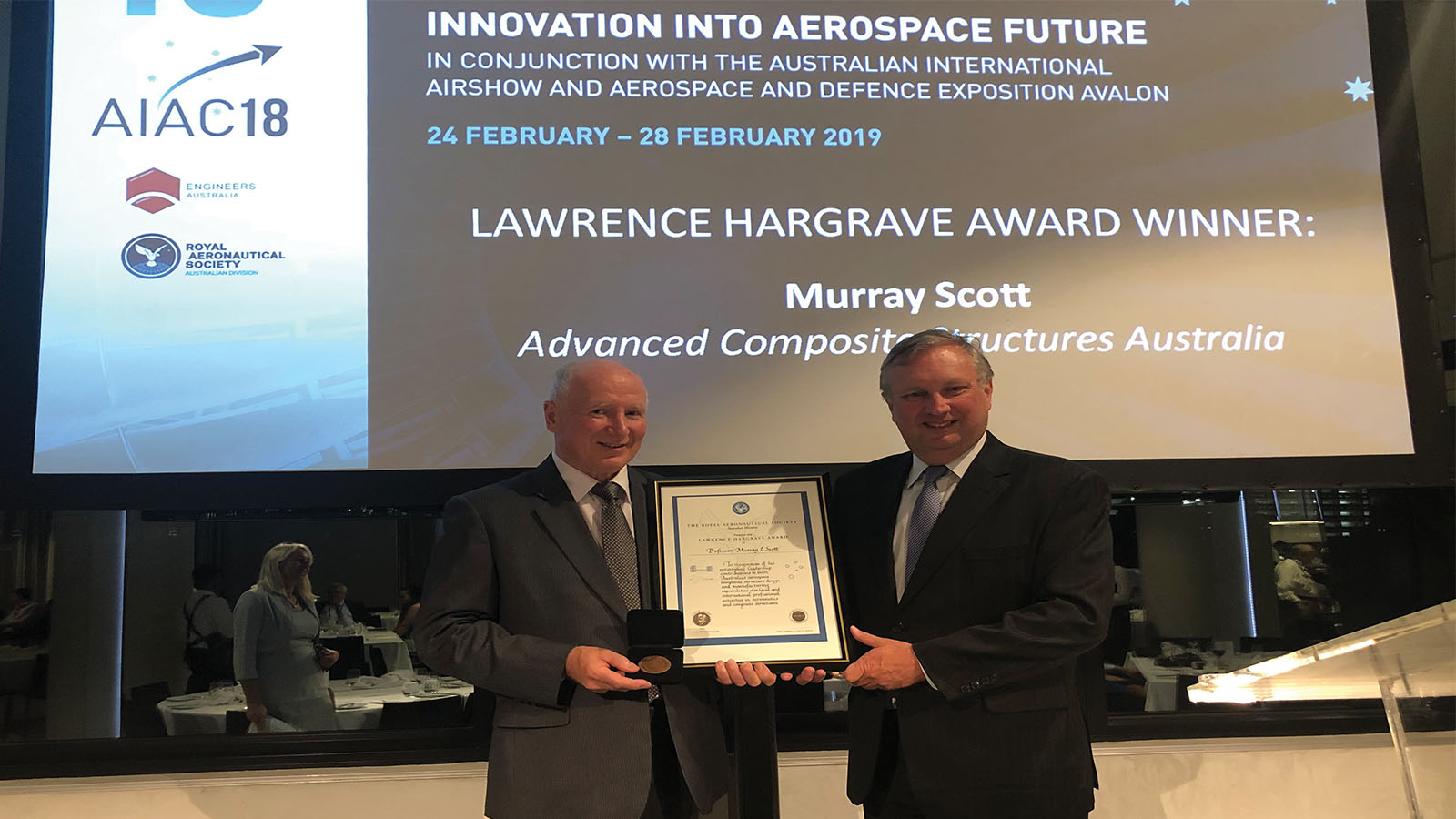
Award Announcements
Professor Scott Wins Hargrave Award
Professor Murray Scott, an AIAA Associate Fellow, is the 2019 winner of the Lawrence Hargrave Award of the Royal Aeronautical Society Australian Division, which recognizes significant contributions to Australian aviation. Professor Scott has been honored for his major contributions to the development of advanced composite materials and structures.
Professor Murray Scott has made an outstanding contribution to the design and manufacturing of advanced fiber-composite aerospace structures, primarily as CEO of the Cooperative Research Centre [CRC] for Advanced Composite Structures. He has also played pivotal leadership roles in establishing other high-value R&D programs such as CRCACS Helicopter Composite Structures, Defence Materials Technology Centre, CRC-ACS Extension Program, and Innovative Manufacturing CRC.
In 1992, Professor Scott founded the Australian Composite Structures Society, which has been instrumental in fostering expertise in advanced composites in Australia. He coedited the book Composite Materials for Aircraft Structures, and has brought a considerable international focus to Australia’s capabilities in aeronautics and composites through attracting major international conferences to the southern hemisphere. Professor Scott is an Honorary Fellow of the International Council of the Aeronautical Sciences and served a two-year term as President. He is also a World Fellow of the International Committee on Composite Materials (ICCM) and has served a term as President.
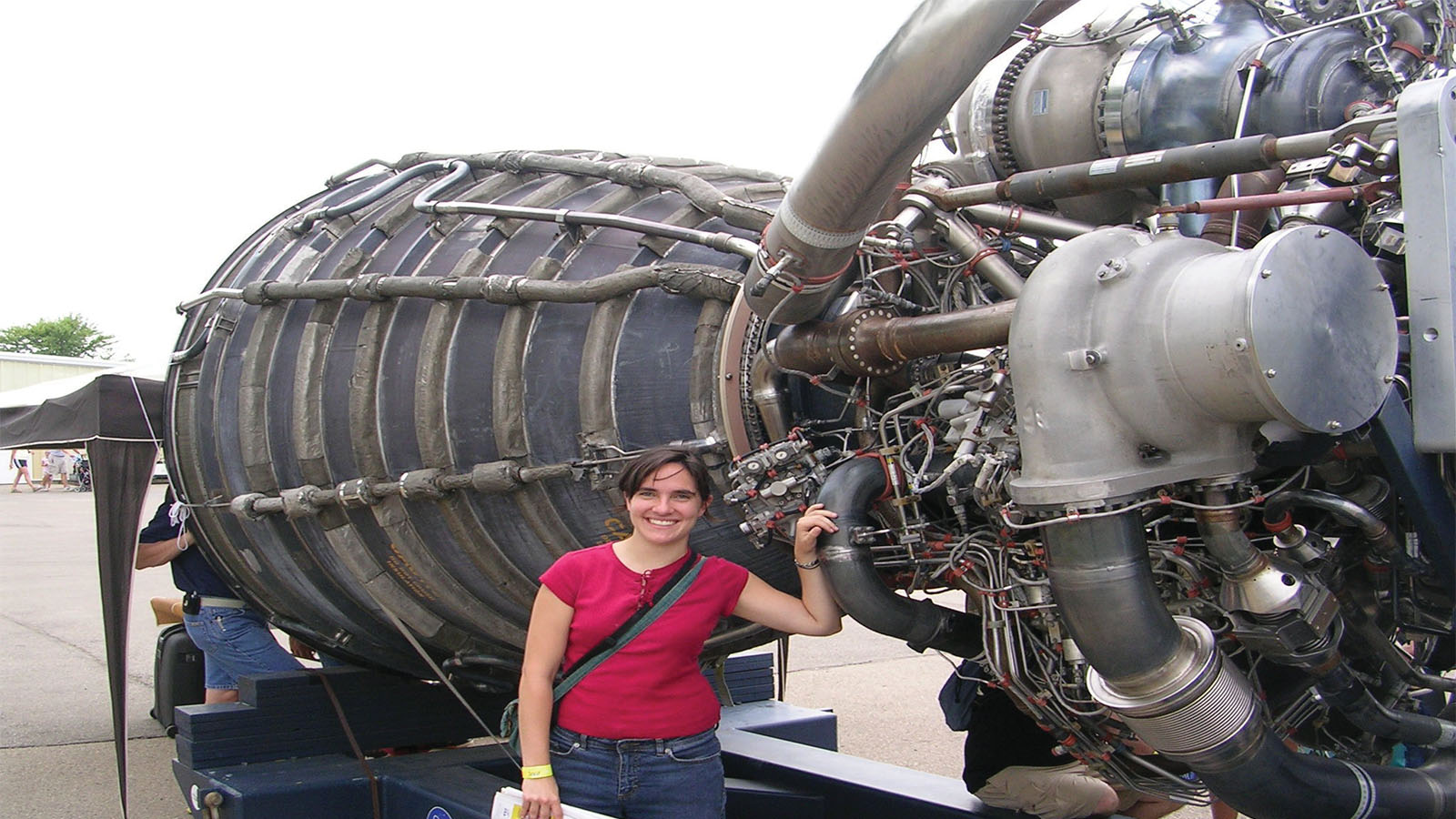
Award Announcements
2019 Sperry Winner Casper Providing New Insights into Hypersonic Boundary-Layer Transition
By Michele McDonald, AIAA Communications
While flying in an ultralight one summer day in Eastern Tennessee when she was 17, Katya M. Casper realized a career in aerospace was for her.
“I was in the air and it was so quiet,” recalled Casper, who was working then at the front desk of a flight school so she could afford to take flying lessons.
Casper is now principal member of technical staff at Sandia National Laboratories in Albuquerque, NM, and is the 2019 winner of the AIAA Lawrence Sperry Award, which is given for a notable contribution made by a young person, age 35 or under, to the advancement of aeronautics or astronautics. Casper won the prestigious award “For highly significant contributions to the fundamental understanding of boundary layer transition and fluid-structure interactions in hypersonic flows through novel diagnostics with national program impact.”
The award was created in 1936 to honor Lawrence B. Sperry, pioneer aviator and inventor, who died in 1923 in a forced landing while attempting a flight across the English Channel. Past recipients of the award include Michael West, Karen Berger, Sally Ride, Eugene Kranz, and Clarence L. “Kelly” Johnson.
Casper joined Sandia full time in 2012 after completing her Ph.D. from Purdue University where she also earned her M.S. in 2009. She received her B.S. in Aerospace Engineering from North Carolina State University in 2007, joining AIAA in her sophomore year.
“Dr. Katya Casper is one of the brightest young engineers I know,” wrote Basil Hassan, AIAA President-Elect and senior manager and program deputy for the Engineering, Stockpile Assessments, and Responsiveness Program at Sandia, when he nominated Casper for the Sperry Award.
Casper’s interest in science started early, encouraged by her father’s love of astronomy. When she was 10 years old, Casper wanted to build the first rover to land on Pluto, drawn to the icy planet because it was so far away. Learning to fly shifted her focus from computer engineering to aerospace. Today, she’s about speed, hypersonic to be exact.
“I like being hands-on and hypersonics is the next frontier,” she said.
Casper develops, conducts, and manages wind tunnel experiments in support of Sandia’s programs. Her work centers on high-speed experimental fluid dynamics, with a focus in hypersonic boundary-layer transition and hypersonic fluid-structure interactions, as well as fluid-structure interactions in subsonic/supersonic cavity flows. She also works to apply traditional wind-tunnel diagnostics to novel applications and testing environments at Sandia.
Simply put, Casper studies how air shakes a vehicle. And no one wants to be shaken at hypersonic speeds. Most of the experiments on boundary-layer transitions have been conducted at low speeds. Casper’s work turns it up a notch and examines how the load on a particular shape—in this case a simple cone—changes in real time the faster it goes.
“We’ve taken a big step forward in the research,” she said.
She’s also applying advanced diagnostics in wind tunnels by using high-frequency pressure sensitive paint to register how a vehicle reacts in a real-world environment.
“We push it to the edge of where the paint can be applied,” she said. “We’ve been applying it in a blast tube facility at Sandia. It’s an outdoor environment where you have sunlight and dust—it’s not a pretty lab environment.”
While you can’t dance to it, she’s also testing how acoustics impact vehicles in flight. Soundwaves, from simple sine waves to more complex sounds found during flight, also receive the paint test. Casper points a bunch of speakers at a structure that’s been coated in the pressure-sensitive paint, turns up the volume, and records the results.
And the results from all her research is impressive.
Casper’s research has provided new insights into hypersonic boundary-layer transitions, noted AIAA Fellow Steven Schneider, a professor in Purdue’s School of Aeronautics and Astronautics. In some cases, revealing that past interpretations were wrong, while in other areas, illuminating problems that have eluded controlled studies for decades.
“Over the last decade, Katya has made major contributions to hypersonic transition,” Schneider wrote in a letter supporting her nomination for the Sperry award. “She is a trusted collaborator who is helping to build a coordinated national team that works well together to meet national goals, both unclassified and classified.”
Casper has been very involved in certain areas of AIAA and was the AIAA International Traffic in Arms Regulation (ITAR) chair in 2015 and 2016 and has been an associate organizer for two technical conferences. She also routinely serves as a journal and fellowship reviewer.
She co-founded a fluid-structure interactions (FSI) discussion group as part of the AIAA Fluid Dynamics Technical Committee. Seven years ago, the group started with three people and has grown to 60 members, who are from academia and the U.S. Air Force. Increased collaboration is the goal for the twice-yearly meetings at AIAA SciTech Forum and AIAA AVIATION Forum.
“We have a vibrant community that’s talking about what we should do in the future,” she said.
For students who want to pursue aerospace or other STEM careers, Casper strongly recommends internships because they offer a chance to try out fields for a short time, unlike regular jobs where it’s usually more difficult to change areas.
Internships helped Casper fine-tune the direction of where she wanted to go in her work. “Internships were absolutely key to my career,” she said.
At NASA she learned about the computational side of aerospace and decided she wanted to conduct experiments. And it was an internship at Boeing where she realized she had to go to graduate school. Working as a Summer Undergraduate Research Fellow in Purdue’s Aerospace Sciences Lab in 2006, she decided where she wanted to study and what she wanted to do.
Casper recommends that students talk to their professors and apply at many places.
“The first internship is the hardest one to get,” she said.
Award Announcements
Three K–12 Educators Win AIAA Foundation Educator Achievement Awards
Three K–12 educators have won the 2019 AIAA Foundation Educator Achievement Awards, honoring their efforts to promote STEM education.
This year’s honorees each received $5,000 for themselves as well as $5,000 for their respective schools. The winners are:
Charlotte Cook, Young Astronaut specialist at Carver Magnet School in Little Rock, AR, for “bringing STEM practices to our school, district, and community by utilizing AIAA and other resources that open students’ eyes to endless possibilities.”
Patricia Palazzolo, Gifted Education Coordinator at Upper St. Clair High School in Upper St. Clair, PA, for “encouraging students to pursue space- and STEM-related careers through hands-on projects and mentorship.”
Megan L. Tucker, Lead Teacher, STEAM Specialist/Gifted & Instructional Facilitator, Technology at Hillsboro Charter Academy in Hillsboro, VA, for “inspiring a love of STEAM nationally for scholars and colleagues alike using aerospace education, Megan has a passionate mission for creating an ‘Aviation Fascination’!”
The AIAA Foundation Educator Achievement Award recognizes K–12 educators for outstanding contributions to the continued study of STEM subjects among America’s youth. Each of these teachers has had a significant impact on creating the next generation of aerospace professionals who will shape our community’s future. Since 1997, the award has honored more than 65 educators from the United States.
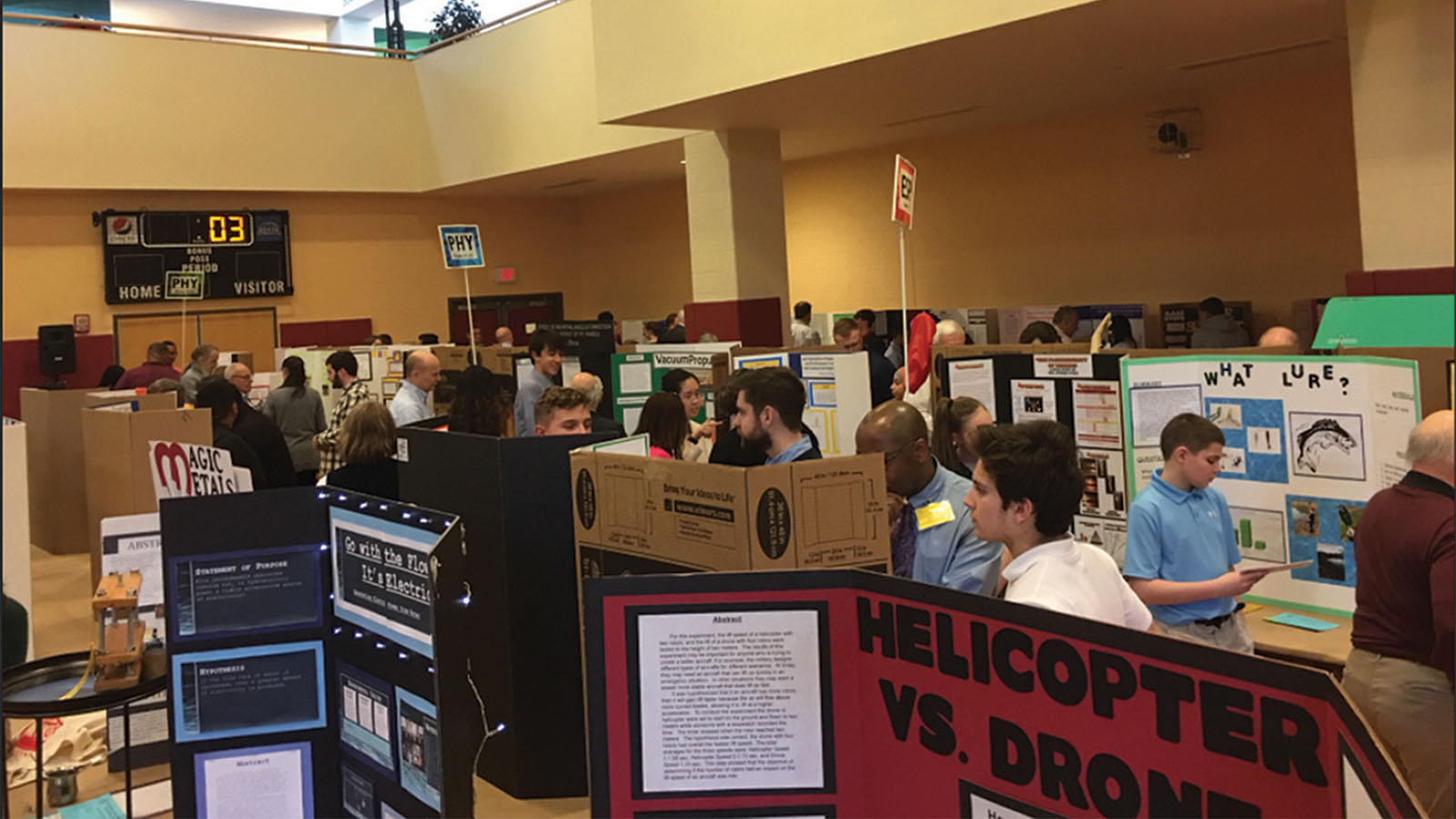
Section News
Northern Ohio Section Judged and Sponsored Special Awards at Area Science Fairs
By Jonathan Kratz
In March, the AIAA Northern Ohio Section (NOS) continued its support of the Northern Ohio regional science fairs by again offering $400 in prizes for aerospace-related projects, which are judged by volunteer members of the section.
The Northwest District Science Day (NWDSD) science fair was held at the University of Toledo on 2 March. Jonathan Kratz and Aaron Hensley of NASA Glenn Research Center (GRC) were on hand to judge the projects, which were grouped into two categories: 5th – 8th grade and 9th – 12th grade— with over 140 total science projects on display. AIAA NOS judges evaluated a number of these science projects broadly related to aerospace engineering and associated sciences. One 1st place and two 2nd place prizes were awarded in each category for a total of six prizes.
Many students put together impressive projects and exhibited a great deal of knowledge and passion toward their topic. Particularly worthy of highlighting is Adley McNeal’s (Grade 11) assembly, programming, and testing of a self-navigating robot with a vision toward potential application to autonomous exploration and mining on Mars; Travis Burnard’s (Grade 7) analysis of strength and deflection in 3D printed parts when considering different infill patterns and their density; and Nipun Jayatissa’s (Grade 12) design and testing of a novel biosensor for detecting heart disease.
The Northeastern Ohio Science and Engineering Fair (NEOSEF) took place at Cleveland State University on 12 March. There were over 450 projects in a wide range of categories covering grades 7–12. The judges were given time to look at the displays, before interviewing around 15 students to select two 1st place winners and four runners up. The judges, who were from NASA GRC, were Jonathan Kratz, Jonathan Litt, Al Juhasz, Yu Hin Hau, and David Sagerser (retired GRC).
A great deal of work was put into these projects and the high level of enthusiasm and extensive knowledge should be acknowledged. Particularly worthy of spotlighting was Michelle Park’s analysis of the modulation of the light curves of stars as a result of their Fe/H values; Brendan Smith’s carefully thought out, sound, and resourceful approach to evaluating the impact of winglets on aircraft range and efficiency; Antonio Linek’s showcase of work and knowledge concerning the use of a vaccum to create a propulsive force; and Jaden Stainforth’s engineering of a track and vehicle for testing a maglev system with application to aircraft take-off.
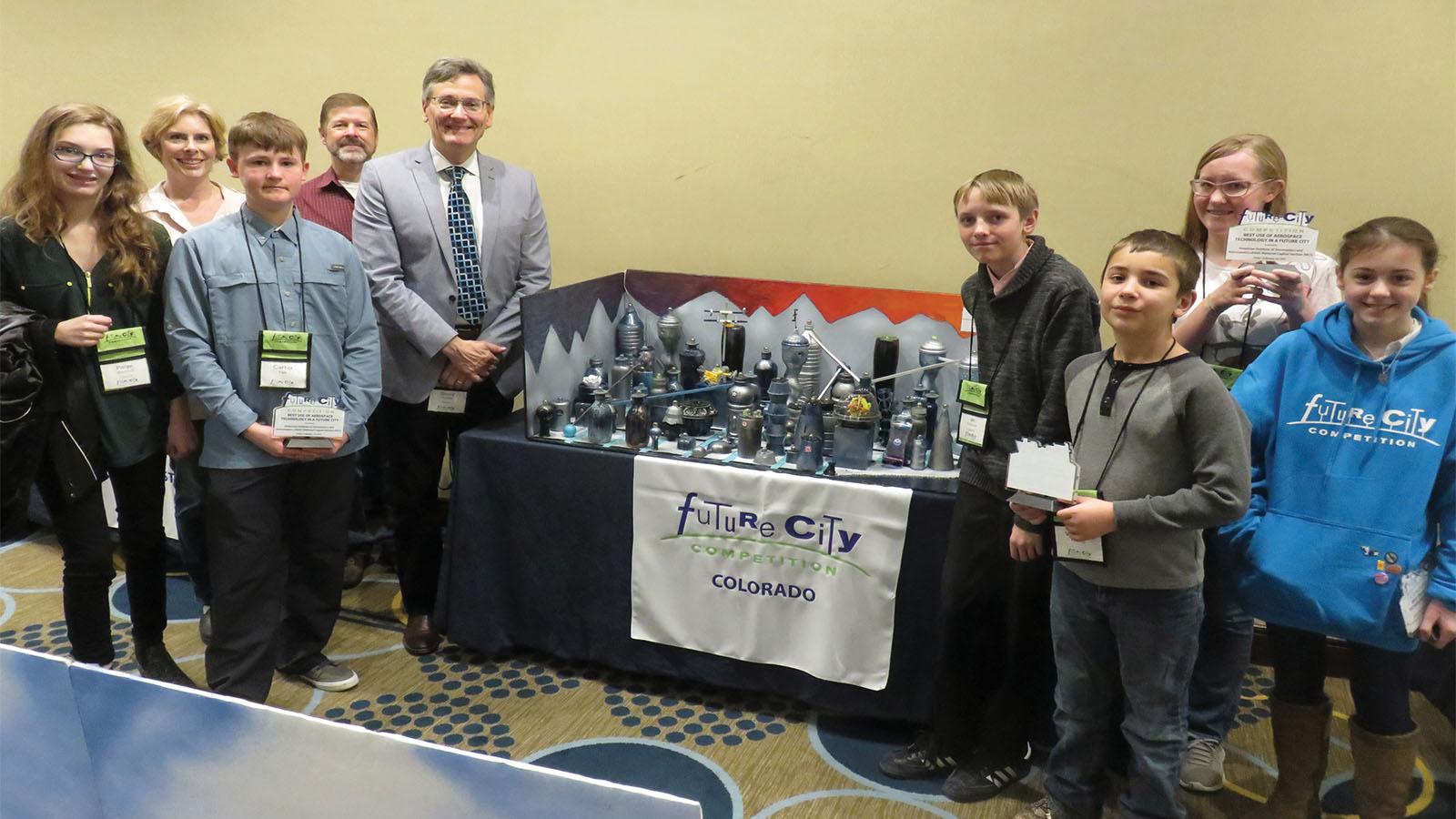
Section News
National Capital Section Presents Future City 2019 SpeciaI Award
By Bruce Cranford
From 16 to 20 February, regional Future City winners from 43 middle schools, after-school organizations (e.g., scouts, 4H, boys/girls clubs) nationwide, Canada, and China participated in the Future City National Finals in Washington, DC. Regional winning teams received an all-expense-paid trip to the National Finals. In its 27th year, this year’s Future City theme was “The Power of the Future,” and middle school students were asked to create cities of the future, first on a computer and then as large tabletop models. Working in teams with a teacher and volunteer engineer mentor, students create their cities using the SimCity 3000 TM video game donated to all participating schools by Electronic Arts, Inc., of Redwood City, CA. Students wrote an abstract and an essay on using engineering to solve an important social issue. Then they presented and defended their cities before engineer judges at the competition. Over 40,000 students from more than 1,350 schools participated in 2018–2019.
The students created detailed — often fantastic — cities of tomorrow that give intriguing insight to how young minds envision their future. At the same time, their bold designs and innovative concepts provide a refreshingly optimistic appreciation of how our nation can realistically deal with the many challenges facing its cities, including the power of public spaces.
As part of the Future City’s program, the AIAA National Capital Section (NCS) presented the 17th annual Special Award for the Best Use of Aerospace Technology to the city named Jotunheim (Team members: Paige Wiethoff, Ian Robinson, Aubrey Morton, William Feeney, Annie Talbot, Carter Fulk. Educator: Dorothy Bleakley, Mentor: Russel Talbott, School: Liberty Classical Academy, Colorado). The AIAA NCS congratulates the team for their outstanding efforts in winning this award. David Brandt, NCS chair, presented the award on 19 February 2019. The award consisted of a savings bond for each student team member, and a plaque highlighting the award for each member of the team.
Thea Sahr (director of Programs and DiscoverE) related the following story about a 2014 Future City student. The student’s mother, Dorothy Bleakley, indicated her son became very interested in aviation and space as a result of his participation in the Future City competition. He will be a freshman in the fall of 2019 at Embry-Riddle Aeronautical University, Daytona Beach, FL, majoring in aeronautical technology. And it just so happens that the school that he helped mentor with his mother this year is the team that won NCS’s Best Use of Aerospace Technology in 2019.
The AIAA NCS wishes to thank the NCS judges for the Best Use of Aerospace Technology: Dr. Ananthakrishna Sarma, Technical Fellow at Leidos, and Bruce Cranford, NCS Social Media Chair. For more information and a list of all the winners, visit futurecity.org.
Obituary
AIAA Fellow Kulpa Died in March 2018
Major General John E. Kulpa Jr. passed away on 12 March 2018 at 88 years of age. General Kulpa graduated from West Point Military Academy in 1950 with a B.S. in military engineering and went on to complete an M.S. in aeronautical engineering at the Air Force Institute of Technology. After serving in the Korean War, he returned home to play a vital role at Air Force Systems Command before joining Space Systems Division at Los Angeles Air Force Station as a project manager.
Following graduation from the National War College in 1969, some of his notable assignments included: commander of the Air Force Avionics Laboratory; director for programs in the Office of Space Systems, and principal deputy for plans at the CIA from 1974 to 1975. After retiring from the Air Force in 1983, he worked with several organizations, including as vice-president at McDonnell Douglas, CEO of the Scorpius Space Launch Corporation, and L.A. County Commissioner, in addition to serving on the boards of a number of companies and universities.
His military decorations and awards include the Distinguished Service Medal with oak leaf cluster, Legion of Merit with oak leaf cluster, Distinguished Flying Cross, Air Medal, Air Force Commendation Medal with oak leaf cluster, and Distinguished Unit Citation emblem. He was the recipient of the prestigious General Thomas D. White Space Trophy in 1980.
Obituary
AIAA Associate Fellow Palmer Died in November 2018
George M. Palmer, a longtime Purdue professor and alumnus, passed away on 13 November. He was 97.
After receiving his bachelor’s in aeronautical engineering from Purdue University in 1945 and working in industry until the end of WWII and getting a graduate degree from Caltech, Palmer joined Purdue as an instructor in the Mechanical Engineering School in 1947. In 1948, Palmer transferred to the School of Aeronautics as it was then called and later was promoted to assistant professor and associate professor.
During his tenure at Purdue, Palmer taught Stability and Control, Airplane Aerodynamics, Jet Propulsion and Rocketry, Space Propulsion, and 490, 590 and 690 Special Individual Projects, all of which invariably used the wind tunnel he designed and built. He retired after 41 years of dedicated service in 1987.
Palmer is best known for his work and tireless efforts in developing Purdue’s wind tunnel program, including designing and constructing The Boeing Wind Tunnel, which was completed in 1950. He later modified it, to provide an open test section for wind engineering studies. That change allowed Purdue to become one of few universities that could test building designs and post mortems that occur due to heavy wind.
Obituary
AIAA Associate Fellow Lewin Died in January
Norman “Norm” Lewin, an aeronautical engineer and executive who helped develop the Lunar Module and avert a calamity on Apollo 13 during his 37-year career at Grumman Corp., died on 14 January. He was 90.
Lewin earned a bachelor’s degree in aeronautical engineering from New York University and a master’s in applied mathematics from Adelphi University. He joined Grumman in 1953, holding numerous positions, including director of engineering and vice president and chief engineer. As chief of guidance and control for the Grumman-built Lunar Module in 1970, Lewin was part of the brainstorming team of engineers that advised NASA on actions to take when an oxygen tank exploded during the Apollo 13 mission, forcing the crew to use the Lunar Module as a lifeboat.
When Grumman was developing the F-14 Tomcat fighter, Lewin worked on aerodynamics, thermodynamics and propulsion. His duties took him aboard the aircraft carrier USS Forrestal to ensure the jets were meetingn performance goals.
Obituary
AIAA Associate Fellow Kastner Died in January
Carl E. Kastner Jr., 87 passed away on 15 January 2019.
After earning a B.S. degree in Engineering from Stevens Institute in 1953, he joined the Army, achieving the rank of SP5.
He returned to New Jersey to pursue his passion for rocket engineering and aeronautics with Reaction Motors, Inc. He was one of 3 patent holders for the Steam Generator for Rocket Engines in 1961 and was involved in the development of engines for the X-15 super-sonic rocket powered airplane. He later spent over 20 years travelling globally to build energy plants with Foster Wheeler Corporation.
Obituary
AIAA Associate Fellow Mason Died in March
William H. Mason, professor emeritus of aerospace and ocean engineering in the College of Engineering at Virginia Tech, died on 27 March. He was 72.
Mason was an expert in aerodynamic and hydrodynamic design and a steadfast member of the Virginia Tech community. He received his bachelor’s degree in 1971, a master’s degree in 1972, and a doctoral degree in 1975, all in aerospace engineering at Virginia Tech.
As an undergraduate student, he gained experience during summers working at McDonnell Douglas in St. Louis, MO, on various F-4 aircraft projects, including the “swing wing” F-4, and for the U.S. Army at Edwards Air Force Base, CA, working on the Huey Cobra helicopter.
After graduating from Virginia Tech, Mason went on to work at Grumman Aerospace in Bethpage, NY, from 1974 to 1989. At Grumman, he served in the structural mechanics section and later in aerodynamics and worked on a number of high-profile projects, including the Grumman X-29, an experimental aircraft that tested a forward-swept wing and canard control surfaces; the NASA/Grumman Research Fighter Configuration, a program to study a super cruiser with low-speed, hi-alpha transonic maneuver, supersonic cruise and supersonic maneuver; and the NASA/Grumman SC3 Wing Concept, which featured an attached flow maneuver wing with controlled supercritical crossflow and set a record at NASA Langley Research Center for low drag at high lift supersonic performance.
He returned to Virginia Tech in 1989, where he educated and advised numerous undergraduate and graduate students in the aerospace engineering degree program over the course of 21 years. He served as graduate advisor for 23 master’s thesis students and nine doctoral students.
His love of aircraft design led him to serve as faculty advisor for many of the department’s undergraduate design teams, most notably the Design/Build/Fly team. In addition, Mason served as the student branch advisor for AIAA for many years.
Mason also acted as assistant director of the Stability Wind Tunnel in the 1990s and 2000s, alongside colleague William Devenport, current director of the Stability Wind Tunnel. During the 2007-2008 academic year, Mason served as a Distinguished Visiting Professor at the U.S. Air Force Academy. During this time, he taught, wrote, and collaborated with Russell M. Cummings, Scott A. Morton, and David R. McDaniel on Applied Computational Aerodynamics: A Modern Engineering Approach.
He was named professor emeritus in 2010. Upon retirement, he continued to teach classes — including his “famous” Configuration Aerodynamics course — and continued to assist with design review and critique for the aircraft design teams.
Throughout his career, Mason authored more than 100 publications and was contributing editor to various book chapters. He was an AIAA Associate Fellow and served on a number of committees, such as the Applied Aerodynamics Technical Committee and the Aircraft Design Technical Committee.
In his memory contributions can be made to the AIAA student branch at Virginia Tech. Checks* made payable to The Virginia Tech Foundation, Inc. can be mailed to: Virginia Tech Advancement (0336), Office of Gift Accounting, 902 Prices Fork Road, Blacksburg, VA 24061. *Note on your check that this gift is “In memory of Bill Mason.”
Stay Up to Date
Submit your email address to receive the latest industry and Aerospace America news.




